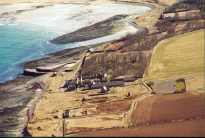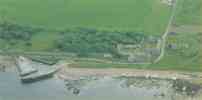| This area was the cradle of
the Flagstone Industry which was begun here last Century by James Traill
of Rattar, Sheriff of Caithness.
The short walk follows the progress of a
piece of flagstone from it being raised in the quarry to shipment from
the harbour. It will reveal the remarkable history behind
Caithness' most versatile and durable natural resource.
Flagstone had long been used as a building material in the north of
Scotland for paving, field dykes, walls and roofing. However when
James Traill came to Castlehill House overlooking the harbour (the house
was destroyed by fire in 1967) he commenced the production of paving
stone on a commercial basis. The first cargo left Castlehill
harbour in April 1825.
The Quarry
The stone was obtained from the quarry which ran from below the car park
and extended up through the Castletown village for almost one
mile. The facility of Caithness sandstone to split into thin
slices or flags(from the norse word 'Flaga' - a flag) occurred because
370 million years ago a Great Lake covered the whole of the north of
Scotland and out into the North Sea. the bed of this lake was
formed by successive layers of sediment. Between the layers the
lake dried out, leaving dead fish (fossils) and the subsequent planes
along which the rock now splits. The flags were raised by hand using
levers. Very little blasting was employed to break up the
rock. At the height of production in 1902, 35363 tonnes of flag
was produced, valued at £23,239 - a huge sum in those days.
The Windmill and Dam
Before the introduction of a steam engine in 1861 the stone was quarried
in dry weather and cut in wet weather when there was water to fill the
dam. The old wind-mill tower is now a scheduled ancient monument
and a unique feature of the site. Originally the building had a
box on the top of the tower which turned face to the wind. Four
vertical sails were fitted to this box. It was used in the very
early days to pump water draining out of the quarry. the water was
pumped into the dam and was then fed through two sluices to operate an
overshot wheel. This then powered the saws.
The Harbour
The harbour was constructed for James Traill by
James Bremner, a native
of Keiss who became famous as a wreck raiser and harbour builder.
The pavement produced in the cutting yard was brought by means of
trolleys and loaded by hand on to the small schooners.
At first the product was shipped to ports down the east coast of
Scotland and England, but as the product became famous it was exported
all over the world, as far as Australia and South America.
The Strand and the concourse of Euston station in London were paved with
Caithness stone which was famed for its quality and durability.
The Cottages
Some of the quarry workers lived in two cottages on the left.
These demonstrate the use of native stone in providing floors, walls and
roofs. Water was obtained from a well just beyond the tunnel which
gave access from the cutting yard. Life was simple, but they had a
garden and probably kept some livestock. The cottages were
continuously occupied until the 1940's. Originally the cottages
were further from the sea. Over the years the waters of Dunnet bay
have encroached on the site, eroding some of the area. To the
right was the cutting yard where the odd shaped 'as quarried' stones
were cut into squares and rectangles.
The Water-Wheel and Cutting Yard
The stone was originally cut by hand using a rough toothed saw held in
wooden guides on the flag and pulled back and forward by two men.
Later, by the 1840's mechanical saws were in operation powered by the
water-wheel set in the pit in front of the dam. These saws were
supported on strong frames about 15 feet high, the base bolts of which
may still be seen. Two pivoted arms swung the saws to and for
across the surface of the flag. Water was used as lubrication and
long boxes above the saws held coarse sand which trickled down into the
saw cut and acted as an abrasive. Although several stones could be
cut at the same time progress was slow and a cut could take two or three
hours. In the early years of this century 500 men were employed
here. Due to the competition from concrete paving and the high
cost of carriage, the works at Castlehill closed in the 1920's.
Interpretive Panels are situated at
strategic points along the Trail. These explain the history and
workings of the flagstone industry.
How The Castlehill
Traill Came To Be by Mike Clark |

